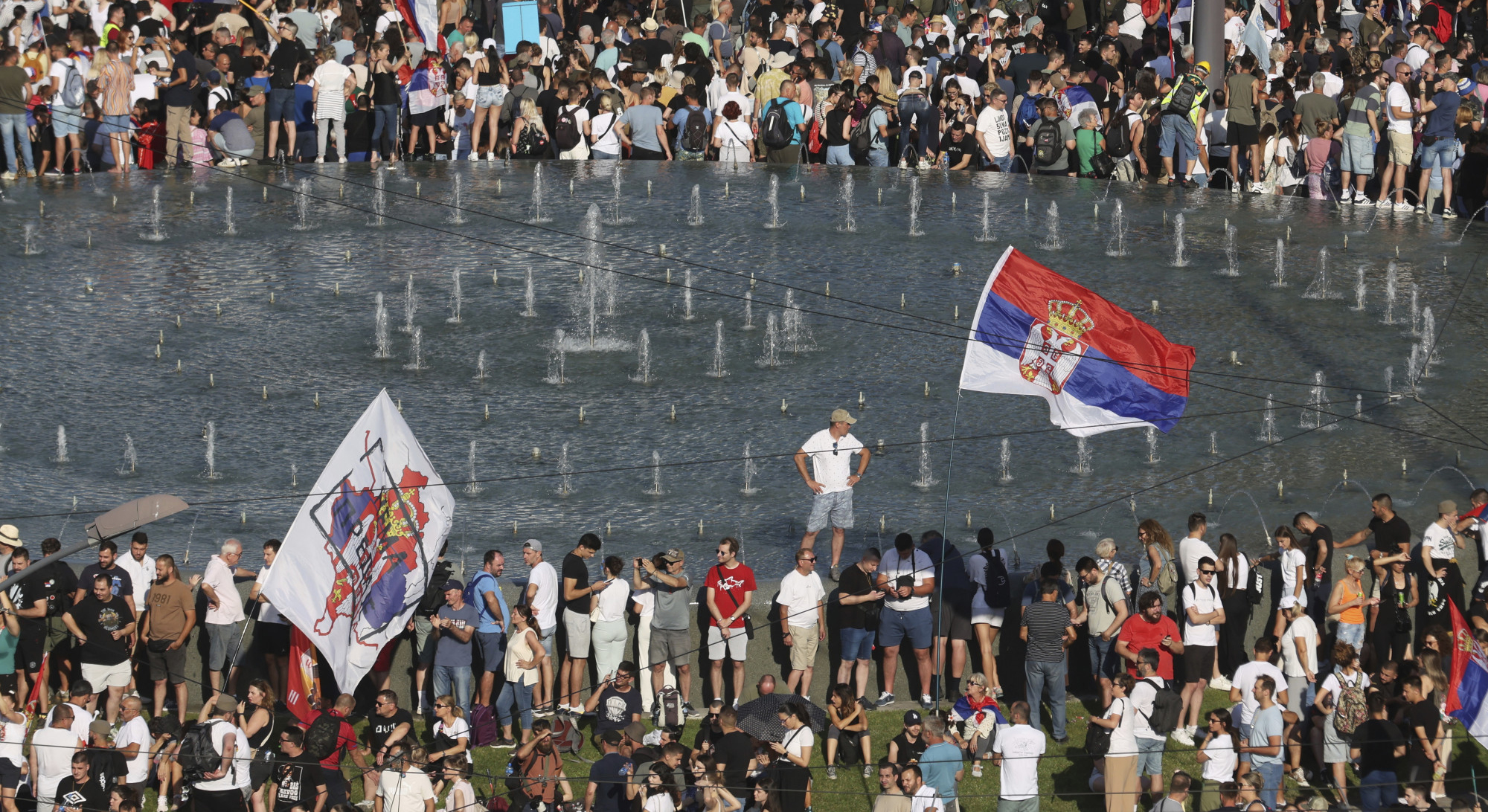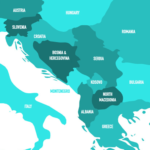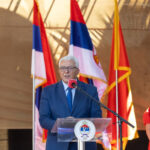The domestic political situation in Serbia is becoming increasingly complex and confusing.
Students protesting against the authoritarian, corrupt regime organize a gathering that turns into a chauvinistic rally.
The authorities, which accused the West of staging a “color revolution” in Serbia, accuse a person associated with russian special services of “attempting to undermine the constitutional order.”
The farther we go, the more it seems that if to talk about foreign interference in Serbian affairs, it is definitely not about Western interference.
Politicization
A mass protest broke out under the motto “Let’s fight for Vidovdan” in Belgrade on June 28, 2025, which ended up in arrests and clashes with police.
The protest was organized by students, who for months, since 2024, have been blocking universities all over the country, organizing rallies and other demonstrations. The reason is Novi Sad tragedy, when the concrete canopy of the main railway station collapsed and killed 16 people on 1 November 2024. Students, activists, and many citizens throughout Serbia took to the streets, demanding criminal and political accountability for those responsible for this tragic event. However, the perpetrators have not yet been identified, let alone punished.
From the fall of last year until the end of spring this year, young people demonstratively avoided politics and politicians, putting forward purely civil demands to the authorities. But this mood gradually changed.
The beginning of summer brought new protests. During another mass rally, which was held in many large and small cities in Serbia about a month ago, students demanded early parliamentary elections. If the elections are not announced “within a reasonable timeframe,” they will launch civil disobedience actions not to allow the system, which, by their definition, ignores public will, to function normally.”
Another manifestation of the politicization of the protests was an open support of opposition candidates by the student movement in the local elections held in two Serbian cities in early June. However, it did not act as a political force.
The “See you on Vidovdan” protest was, in fact, the first mass political gathering of the civic student protest movement.
What did the Belgrade protest on June 28 reveal?
Radicalization
It has become clear that among the protesters, there is a significant number of determined young people ready to clash with the police. Following a large rally at Slavija Square in Belgrade, several skirmishes erupted between protesters and police, providing journalists worldwide with impressive images of confrontations between citizens and law enforcement on the streets of Belgrade.
The Serbian leadership has traditionally accused the protesters of attempting a violent overthrow of the government, calling it “terrorism,” with the object of encouraging a “color revolution.” Pro-government media and commenters have even warned of a civil war threat. However, frankly speaking, there is insufficient evidence to support such dramatic accusations.
The protesters, in turn, have failed to clearly explain the reasons of the clashes and why they headed toward the government quarter after the formal end of the rally. Fully equipped police were waiting for them there.
In any case, the events of late June have shown that both sides are ready for an escalation, to “raise stakes.” The authorities have decided to present the protest movement as anti-state rebels, while the protesters have demonstrated their readiness for more radical actions.
Vidovdan Protest
The call for the radicalization of the protest movement was not the only new trend noticeable during Vidovdan. The unexpected ideological coloring of the protest surprised people even more.
On June 29, Tomislav Marković, journalist and publicist, wrote in detail about this for Al Jazeera’s Balkan edition. His main conclusions (which were supported by many other regional experts) are the ideology proclaimed at the rally was not liberal-democratic, nor civic or human rights-oriented, but rather chauvinistic and a “Greater Serbia”.
The symbol of the bloody hand on banners, intended to remind people of the Novi Sad tragedy, the need to punish those responsible, and pervasive corruption, was overshadowed by flags with a map of Kosovo and the slogan “No Surrender” (“Nema predaje”), Dušan Pajović, political analyst, said on Radio Free Europe.
Not only Kosovo but also other countries was discussed in the context of protecting Serbian interests.
During the speeches of many orators at the Vidovdan rally, “the audience got the impression that they had traveled back to 1989 and were watching Slobodan Milošević at Gazimestan,” Marković noted.
Political commentator Dragan Bursać, in his interview with RSE, described the June 28 protest gathering as a “Chetnik orgy.”
As it was announced, the action was planned for Vidovan, which raised some suspicions. However, after the rally, there was no longer any doubt — the protest movement, as it is, began to sidestep the authorities “to the right,” demonstrating more pro-Serb sentiments rather than the expected greater democracy or European orientation.
The New Phase of Confrontation
The authorities, for their part, continued its tough confrontation with those participating in anti-government protests. There are no signs that President Aleksandar Vučić is preparing to announce early elections, as it was demanded. On the contrary, it seems that the current Serbian authorities have decided to “put pressure” on the protesters and stop all blockades, all protest rallies and marches by repressive measures.
To do this, the authorities present the protest movement not as an opposition force, not as political opponents, or as civil resistance, but as “terrorists” and insurgents preparing a violent overthrow of the government.
On the eve of June 28, during a joint operation by the police and special services, several people were arrested on the charge of alleged preparation to seize the buildings of state institutions and pro-government media and to violate the “constitutional order” of the country. Several more “rioters” ended up behind bars on the same charges after the Vidovdan protest. More than 70 (!) protesters were detained on the night of June 29, after clashes between demonstrators and police.
In response, students and citizens began blocking roads in Serbia, but mainly in Belgrade.
Confrontation between the authorities and displeased citizens has entered into a new phase.
Officials and pro-government media in Serbia are actively promoting the idea that such a harsh reaction to excessively violent civil protests is normal for any democratic country. But there are suggestions that Belgrade is focusing more on Eastern than Western experience in combating mass protests.
A “Second-Hand” Plan
The key markers of the “eastern” approach of the Serbian authorities to countering the protest movement are the use of the term “color revolution” to characterize the protests, constant accusations of “foreign (Western) interference,” and, finally, constant consultations with russian special services.
That is, Vučić, according to this scenario, acts as a fighter against an attempted violent change in the government organized by the West.
It seems that this instruction was written in Moscow quite a long time ago. First, Yanukovych tried to use it in Ukraine, then Lukashenko in Belarus… Now Vučić is also using this “second-hand” plan… So far, it doesn’t seem to be going well.
Firstly, the current Serbian authorities are quite pro-Western.
Serbian high-ranking officials are constantly either receiving Western leaders in Belgrade or traveling to Western countries on visits. Serbia is actively using Western investments and special funding from the EU as a candidate for accession. Belgrade is not going to give up its intention to join the European Union. Moreover, the Serbian military is even conducting joint exercises with NATO (these days, another Platinum Wolf multinational military exercises took place, which were organized by the Serbian military together with the Americans).
Secondly, despite all the accusations of the Serbian authorities against the West about attempts to organize a “color revolution” in Serbia, there is insufficient evidence of the involvement of Western states in organizing the protests.
Thirdly, the protest movement itself is not 100% pro-Western.
It has already been noted that the last large rally that in Belgrade on Vidovdan was similar to a “Greater Serbia” gathering. But even before that, the protesters did not demand, for example, accelerated accession to the EU or Euro-Atlantic integration. True, student delegations visited European structures in Strasbourg and Brussels, but there was no the EU flag at the protests (it seems that it was not there at all).
The Russian Game
Fourthly – and probably the spiciest moment – there is an opposition representative known for his ties with the FSB among those accused of organizing the “violent overthrow of power” in Serbia.
This is the former head of the Serbian Military Trade Union, Novica Antič.
Earlier, Politico called Antič a possible russian agent of influence, underlining that one of the Western intelligence agencies accused him of ties with russian special services, in particular, the FSB.
“Antič is known as a consistent supporter of strengthening friendly and allied relations between Russia and Serbia, and an active civic position in protecting the rights of Serbian military personnel – veterans of the war in Yugoslavia,” wrote the russian Versiya.
According to Versiya, the Serbian authorities could have declared the demonstrators participating in the anti-government protests “FSB agents,” after the detention of Antic.
This did not happen. Obviously, such conclusions can be drawn against the background of this data about the “rioters”. It is difficult, even impossible, to claim that the West is behind the protests.
Taking into account the fact that the Serbian authorities cooperate with russian special services, one may get the impression of some Kremlin’s complex game. One might even think that Moscow has intentionally decided to play for both teams, trying either to weaken or even remove Vučić, or to destabilize Serbia, the Western Balkans, and Southeast Europe in general.



